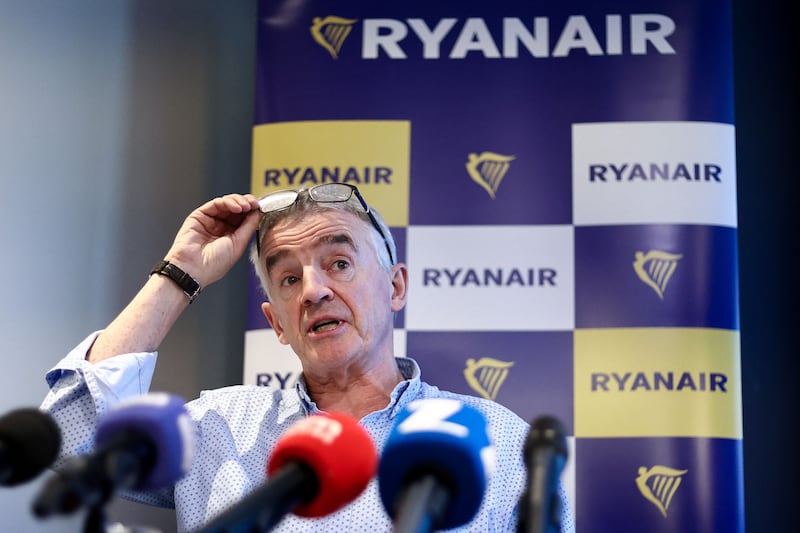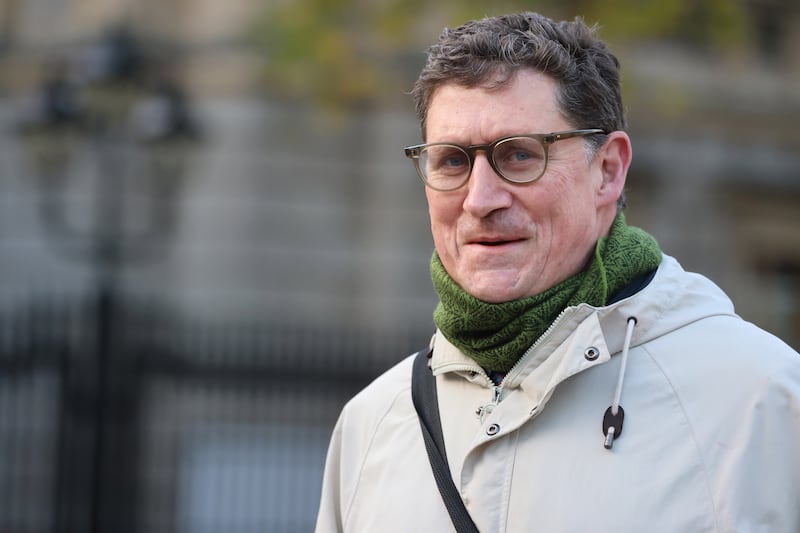Dublin Airport is reaching capacity. A review by Oxford Economics for the Department of Transport five years ago had a baseline scenario of it reaching 54 million passengers by 2050. Last year the airport struggled to cope with 28 million.
A shortage of security staff led to queues outside the terminals, and on the last Sunday in May some 1,400 passengers missed their flights. There were complaints about cleanliness and the state of the toilets. This summer the problem will be parking, with the closure of a privately owned car park near the airport reducing capacity by one fifth. There are often long queues for taxis, and there will be no rail link from the airport to Dublin city centre until 2035, if ever.
The opening of a second runway last September set off a barrage of complaints from residents about noise. The Dublin Airport Authority (DAA) has gone to the High Court in a bid to cancel part of Fingal County Council’s local development plan, on the basis that it prescribes noise-mitigation measures that could cost up to €1.8 billion.
Fingal councillors also changed the zoning of 6.7 hectares of DAA land to “community infrastructure”, which means it cannot be used for aviation. Now another important piece of adjoining land is up for sale. As revealed by The Irish Times on Tuesday, property owners including Ulick and Des McEvaddy are selling a 106-hectare land bank between the two runways, that they believe is worth hundreds of millions of euro. The “for sale” ads cheekily note these are “unique lands essential to future growth of the airport”.
READ MORE
Already, Dublin Airport handles about 90 per cent of Irish air traffic. The expectation is that it will continue to grow, eventually adding a third terminal. But is that the best option for the city, or the country? Given that it is hemmed in on a relatively constricted site, surrounded by congested roads and with no rail link, maybe Dublin Airport should not grow any further. Maybe we should look at alternatives.
[ What does the McEvaddy land sale mean for the future of Dublin Airport?Opens in new window ]
Here are the options.
1. Build a third terminal at Dublin Airport
The Oxford Economics review for the Department of Transport said: “We find that a new terminal, built in phases and ultimately serving 20 million passengers per year, would be an appropriate response to [Dublin Airport’s] capacity requirements.”
Ryanair’s Michael O’Leary has said the economic case for a third terminal could be hard to make. His preferred option is for 10 to 20 new departure gates to be installed in hangar space next to Terminal 1
The DAA doesn’t agree. It thinks a better plan is to expand Terminals 1 and 2, with new boarding gates and aircraft parking stands. Under the terms of its planning permission, however, the capacity for both terminals cannot exceed 32 million passengers per year. Once that cap is reached, the DAA will either have to apply for new planning permission or go for a third terminal.

There are strong views on both sides. Evan Cullen, who recently stepped down as president of the Irish Airline Pilots’ Association, says a third terminal is needed as soon as possible, and should be built to the west of the airport near the N2. He doesn’t want the DAA to operate it.
Ryanair’s Michael O’Leary has said the economic case for a third terminal could be hard to make. His preferred option is for 10 to 20 new departure gates to be installed in hangar space next to Terminal 1, Ryanair’s hub, linked by a walkway.
2. Develop Baldonnel as a commercial airport
Casement Aerodrome, at Baldonnel, is the headquarters of the Irish Air Corps. Queen Elizabeth II and Douglas “Wrong Way” Corrigan are among the civilian passengers who have landed there. The idea of developing a commercial airport alongside the military one has been around since the 1990s. The late Tony Ryan, the founder of Ryanair, was a supporter.
More recently, the case was made by Pádraig Ó Céidigh, the former owner of Aer Arann, when he was a senator in 2018. The businessman pointed out that Belfast has two airports, as does Glasgow, while Warsaw, with a smaller population than the Greater Dublin Area, has three. Milan also has two, as does Brussels.
He added: “Baldonnel is in south Dublin and just off the M50. There is a Luas stop within five minutes and the State owns the site.” Other factors in favour of developing Baldonnel, even just for flights to and from the UK, are that its runway has the capacity to take most commercial planes, and it’s a greenfield area.
The idea was considered by the Fine Gael-led coalition government in 1996, but rejected. Yet in its election manifesto for 2007, Fine Gael proposed building a new airport in west Dublin. “With population growth and passenger numbers increasing rapidly,” the then Fine Gael leader Enda Kenny said, “I believe that if we are going to plan for the next 20 to 30 years, we need to look at a second airport for Dublin after examining current resources and other greenfield sites.”
Fine Gael lost that election, and the financial crisis of 2008 would have stopped them building a new airport even if they had won.
3. Build a new airport in the midlands
How about developing a new airport elsewhere? A plan to construct one in Offaly, near Tubber, was drawn up by Midland Airport Development Ltd, which proposed an international trade and distribution zone anchored by a cargo and passenger airport with a 3.5km runway “to act as a reliever of pressure on Dublin Airport”. Offaly County Council supported the idea, but councillors dropped it from the county development plan in 2021.
The lack of official appetite for putting an international airport in Ireland’s ‘hidden heartlands’ was surely reflected in the fact that the company did not succeed in getting a grant from the Rural Generation and Development Fund, which has €1 billion to spend.
Fergal McCabe, a town planning consultant from Tullamore who opposed the project, said building a new airport has to be a top-down decision from government, “and then you look at the whole country and decide where it goes, and where you need it, rather than someone buying a few acres in Offaly and pushing it through the planning process”.
“I felt, before the development of the second terminal at Dublin Airport [in 2010], that we would be better off building an airport in the midlands, with high-speed networks to the big cities from there, like the Stansted model,” says economist Jim Power. He now accepts: “It’s just not going to happen.”
4. Expand Cork and Shannon
Forget about building a new airport; why not develop one of the eight – yes, eight – we already have apart from Dublin? A runway extension is planned at Waterford, where there have been no flights since June 2016. There’s also tumbleweed rolling down the (short) runway at Sligo, from which Aer Arann once flew to Dublin.
Donegal has twice-daily flights to Dublin, and twice-weekly to Glasgow, while Kerry has a wider menu, including Faro and Alicante, and Knock offers 16 destinations. Realistically, though, the case for developing regional airports as a counterweight to Dublin centres on Cork and Shannon.
The airlines don’t say, ‘I am going to take this route and move it to Cork, and it’s going to work just as well.’ The demand just doesn’t transfer
— Kenny Jacobs, chief executive of the DAA
The study by Oxford Economics in 2018 predicted that passenger numbers at Cork would reach 4.1 million in 2050, while at Shannon it would be 3.3 million. Both airports had sufficient runway capacity to meet demand up to then. So how about going further, and deflecting business from Dublin in their direction?
It’s not that simple, according to Kenny Jacobs, chief executive of the DAA, which has responsibility for both Cork and Dublin. “The airlines don’t say, ‘I am going to take this route and move it to Cork, and it’s going to work just as well’,” he told the Irish Examiner this week. “The demand just doesn’t transfer.”
Eamon Ryan, the transport minister, seems to be a big fan of Shannon, however, and has suggested it could be used to test projects aimed at more environmentally friendly aviation. Shannon has strategic advantages, such as a direct connection to a deepwater jetty so any ship could come in to deliver fuel, Ryan recently told the Dáil. “It has under-apron storage facilities... unlike Dublin Airport where fuel must be trucked up from Dublin Port.”
Shannon also has a “very long runway and can take heavier loads”, and transatlantic flights from there have a lower carbon footprint due to the shorter distance, plus there’s “lower circling times because of less congestion”, Ryan added.
5. Put a cap on flights
Surely, in order to halve our greenhouse gas emissions by 2030 and reach net zero by 2050, the Government needs to stop the expansion of aviation? France has banned internal short-haul flights where there is a train alternative, while the Dutch government is planning to cut the number of international flights leaving Schiphol airport in Amsterdam.

Yet not even the Green Party leader is in favour of such ideas here. “I am afraid it is not possible to cap the number of flights,” transport minister Eamon Ryan told the Dáil in December. “We have benefited from international aviation being organised on a liberal basis with no restrictions. We cannot go back to the days when it was not possible to fly into Dublin.”
The sector has fully bounced back post-pandemic, with the public as enthusiastic as ever about taking to the air, whatever the environmental implications
Ireland is an island, so the only way off is by ferry or plane. Just as importantly, these are the only ways in. That’s not going to change in this century – a recent feasibility study into building a bridge or tunnel to Scotland, an idea championed by former British prime minister Boris Johnson, found it would be impractical and too expensive.
[ Dublin airport warns passengers all parking spaces are sold outOpens in new window ]
Prior to Covid, almost 7 per cent of GDP was supported by air transport and foreign tourists arriving by air. The sector has fully bounced back post-pandemic, with the public as enthusiastic as ever about taking to the air, whatever the environmental implications. Some 425,000 people will travel through Dublin Airport this weekend, the same as over the 2019 June bank holiday. Cork is ahead of where it was in 2019.
“People want to travel, and have to travel,” says Power. “Socially and politically, restricting air travel just would not work. There would be no popular acceptance of it whatsoever.”
Instead, the sector’s carbon footprint will be reduced by measures such as obliging airlines to use a certain level of Sustainable Aviation Fuel (SAF) from 2025. Ryan has said Shannon has “the potential to be a leading airport in the development of new sustainable aviation fuels”.
If we really want an alternative to the expansion of Dublin, then, we should probably be looking west. In practical terms, however, letting Dublin take off is by far the most likely option.



















